Analysis of Temporal and Spatial Variations in Cropland Water-Use Efficiency and Influencing Factors in Xinjiang Based on the XGBoost–SHAP Model
Abstract
1. Introduction
2. Materials and Methods
2.1. Overview of the Study Area
2.2. Data Sources and Preprocessing
- (1)
- Land-use data
- (2)
- Vegetation data
- (3)
- Meteorological data
2.3. Data Analysis
- (1)
- WUEc Definition
- (2)
- Temporal Correlation Analysis
- (3)
- Analysis of Spatial Trends
- (4)
- Sustainability Analysis
- (5)
- Stability Analysis
- (6)
- Visualizing Machine Learning Models (XGBoost–SHAP)
- (7)
- Analysis of Dominant Factors
3. Results
3.1. Characterization of Spatial and Temporal Variations of WUEc
3.2. Sustainability and Stability Analysis of WUEc
3.3. Attribution Analysis of WUEc Changes in Xinjiang
3.3.1. The Response of WUEc Variation to Climate and Vegetation Factors
3.3.2. Analysis of Dominant Factors in WUEc Changes
3.4. Nonlinear Relationships and Effective Thresholds of Influencing Factors on WUEc
4. Discussion
4.1. Attribution Analysis of the Spatiotemporal Variations in WUEc in Xinjiang
4.2. The Impact of Meteorological Factors on WUEc Variation
4.3. The Impact of Vegetation Factors on WUEc Dynamics
4.4. Potential Applications and Limitations
5. Conclusions
Author Contributions
Funding
Data Availability Statement
Conflicts of Interest
References
- Scheierling, S.M.; Tréguer, D.O. Beyond Crop per Drop: Assessing Agricultural Water Productivity and Efficiency in a Maturing Water Economy; World Bank: Washington, DC, USA, 2018. [Google Scholar]
- Zhang, P.; Long, A.H.; Hai, Y.; Deng, X.Y.; Wang, H.; Liu, J.; Li, Y. Spatiotemporal variations and driving forces of agricultural water consumption in Xinjiang during 1988–2015: Based on statistical analysis of crop water footprint. J. Glaciol. Geocryol. 2021, 43, 242–253. [Google Scholar] [CrossRef]
- Cao, R.C.; Hu, Z.G.; Jiang, Z.Y.; Yang, Y.T.; Zhao, W.; Wu, G.; Feng, X.M.; Chen, R.R.; Hao, G.G. Shifts in ecosystem water use efficiency on China’s Loess Plateau caused by the interaction of climatic and biotic factors over 1985–2015. Agric. For. Meteorol. 2020, 291, 108100. [Google Scholar] [CrossRef]
- Farquhar, G.D.; Schulze, E.D.; Kuppers, M. Responses to humidity by stomata of Nicotiana-glauca l and Corylus-avellanal are consistent with the optimization of carbon-dioxide uptake with respect to water-loss. Aust. J. Plant Physiol. 1980, 7, 315–327. [Google Scholar] [CrossRef]
- Liu, C.; Liu, B.; Zhao, W.Z.; Zhu, Z.C. Temporal and spatial variability of water use efficiency of vegetation and its response to precipitation and temperature in Heihe River Basin. Acta Ecol. Sin. 2020, 40, 888–899. [Google Scholar] [CrossRef]
- Hatfield, J.L.; Dold, C. Water-use efficiency: Advances and challenges in a changing climate. J. Front. Plant Sci. 2019, 10, 103. [Google Scholar] [CrossRef]
- Du, X.Z.; Zhao, X.; Zhou, T.; Jiang, B.; Xu, P.P.; Wu, D.H.; Tang, B.J. Effects of climate factors and human activities on the ecosystem water use efficiency throughout northern China. Remote Sens. 2019, 11, 2766. [Google Scholar] [CrossRef]
- Dong, Y.L.; Li, Y.B.; Ma, Y.Z.; Wan, S.M.; Dong, H.Q.; Yang, B.F.; Feng, L.; Gao, F.; Zhou, J.; Wang, C. Response of soil moisture spatiotemporal variations and utilization efficiency to planting density in cotton fields in arid regions. Agric. Res. Arid Areas 2025, 1, 168–179. [Google Scholar] [CrossRef]
- Huang, M.T.; Zhai, P.M.; Piao, S.L. Divergent responses of ecosystem water use efficiency to drought timing over Northern Eurasia. Environ. Res. Lett. 2021, 16, 045016. [Google Scholar] [CrossRef]
- Mu, Y.M.; Jia, X.; Ye, Z.Q.; Guo, X.L.; Hao, S.R.; Zhao, T.S.; Zhang, Y.Q.; Han, C.; Gao, S.; Xing, F.; et al. Vegetation factors and atmospheric dryness regulate the dynamics of ecosystem water use efficiency in a temperate semiarid shrubland. J. Hydrol. 2024, 639, 131644. [Google Scholar] [CrossRef]
- Aaron, H.; Gabriela, P.Q.; Hannah, D. The development and current challenges of irrigated agriculture in the western U.S. Agric. Water Manag. 2025, 315, 0378–3774. [Google Scholar] [CrossRef]
- Lin, S.; Wang, G.X.; Hu, Z.Y.; Sun, X.Y.; Song, C.L.; Huang, K.W.; Sun, J.; Yang, Y. Contrasting response of growing season water use efficiency to precipitation changes between alpine meadows and alpine steppes over the Tibetan Plateau. Agric. Water Manag. 2023, 289, 108571. [Google Scholar] [CrossRef]
- Wang, F.; Wang, Z.; Huang, J.; Yang, S.J.; He, G.J.; Zhang, Y. Spatio-temporal distribution characteristics of cropland water use efficiency and its relationship with climate in Anhui Province. Acta Ecol. Sin. 2019, 38, 6268–6279. [Google Scholar] [CrossRef]
- Chang, M.; Shi, H.G.; Yuan, S.Y.; Chen, K.L.; Zhang, X.Y.; Zhang, J.H. How does farmer differentiation effect agricultural water use efficiency? Evidence from China. Agric. Water Manag. 2025, 312, 0378–3774. [Google Scholar] [CrossRef]
- Nie, C.; Huang, Y.F.; Zhang, S.; Yang, Y.T.; Zhou, S.; Lin, C.J.; Wang, G.Q. Effects of soil water content on forest ecosystem water use efficiency through changes in transpiration/evapotranspiration ratio. Agric. For. Meteorol. 2021, 308, 108605. [Google Scholar] [CrossRef]
- Térán, C.P.; Naz, B.S.; Graf, A.; Qu, Y.Q.; Franssen, H.-J.H.; Baatz, R.; Clais, P.; Vereecken, H. Rising water-use efficiency in European grasslands is driven by increased primary production. Commun. Earth Environ. 2023, 4, 95. [Google Scholar] [CrossRef]
- Shang, B.; Agathokleous, E.; Calatayud, V.; Peng, J.; Xu, Y.; Li, S.; Liu, S.; Feng, Z. Drought mitigates the adverse effects of O3 on plant photosynthesis rather than growth: A global meta-analysis considering plant functional types. Plant Cell Environ. 2024, 47, 1269–1284. [Google Scholar] [CrossRef]
- Guo, L.M.; Shan, N.; Zhang, Y.G.; Sun, F.B.; Liu, W.B.; Shi, Z.J.; Zhang, Q. Separating the effects of climate change and human activity on water use efficiency over the Beijing-Tianjin Sand Source Region of China. Sci. Total Environ. 2019, 690, 584–595. [Google Scholar] [CrossRef]
- Tian, F.; Yang, J.H.; Du, R.H.; Lin, J.H.; Chen, M.; Wu, J.J. Sustained vegetation greening enhanced ecosystem water-use efficiency in the Loess Plateau of China in recent 20 years. Ecol. Eng. 2022, 184, 106768. [Google Scholar] [CrossRef]
- Wang, L.M.; Li, M.Y.; Wang, J.X.; Li, X.G.; Wang, L.C. An analytical reductionist framework to separate the effects of climate change and human activities on variation in water use efficiency. Sci. Total Environ. 2020, 727, 138306. [Google Scholar] [CrossRef]
- Wang, Y.; Tong, X.; Li, J.; Yang, M.; Wang, Y. Impacts of Climate Change and Human Activities on Vegetation Productivity in China. Remote Sens. 2025, 17, 1724. [Google Scholar] [CrossRef]
- Sun, H.; Fang, G.F.; Ruan, L.L.; Li, S.N.; Zhang, L. Spatiotemporal Patterns and Drivers of Carbon and Water Fluxes in Semi-Arid Regions of Asia. Acta Ecol. Sin. 2022, 42, 4742–4757. [Google Scholar] [CrossRef]
- Hu, Z.Y.; Dai, Q.H.; Yan, Y.J.; Zhang, Y.; Li, H.Y.; Zhou, H. Dissecting the characteristics and driver factors on global water use efficiency using GLASS data sets. Earth’s Future 2024, 12, e2024EF004630. [Google Scholar] [CrossRef]
- Yu, H.C.; Li, S.E.; Ding, J.; Yang, T.Y.; Wang, Y.X. Water use efficiency and its drivers of two typical cash crops in an arid area of Northwest China. Agric. Water Manag. 2023, 287, 108433. [Google Scholar] [CrossRef]
- Tian, F.; Zhang, Y.; Lu, S. Spatial-temporal dynamics of cropland ecosystem water-use efficiency and the responses to agricultural water management in the Shiyang River Basin, northwestern China. Agric. Water Manag. 2020, 237, 106176. [Google Scholar] [CrossRef]
- Li, H.; Liu, T.J.; Wang, S.H.; Liu, D.W. Spatial and temporal variation of water use efficiency and its influencing factors in desert steppe of Inner Mongolia from 2001 to 2021. Arid. Land Geogr. 2023, 47, 993–1003. [Google Scholar] [CrossRef]
- Li, Y.L.; Wu, X.Q.; Yuan, Y.; Dong, L.B. Spatial-temporal evolution and driving mechanism of vegetation carbon and water use efficiency in Heilongjiang Province, China. Chin. J. Appl. Ecol. 2024, 35, 3349–3358. [Google Scholar] [CrossRef]
- Wang, F.Y.; Xia, J.; Zou, L.; Zhang, L.P.; Li, X.Y.; Yu, J.R. Spatio-temporal heterogeneity and driving mechanism of ecosystem water use efficiency in the Loess Plateau, China. J. Hydrol. Reg. Stud. 2024, 56, 2214–5818. [Google Scholar] [CrossRef]
- Seka, A.M.; Zhang, J.H.; Ayele, G.T.; Demeke, Y.G.; Han, J.Q.; Prohan, F.A. Spatio-temporal analysis of water storage variation and temporal correlations in the East Africa lake basins. J. Hydrol. Reg. Stud. 2022, 41, 101094. [Google Scholar] [CrossRef]
- Zhao, T.L.; Liu, W.; Li, Z.; Xu, Z.; Yang, K.; Wu, D. Analyses of the evolution and influencing factors of natural runoff in China based on STL decomposition. J. Hydraul. Eng. 2025, 56, 216–226+239. [Google Scholar] [CrossRef]
- Li, H.D.; Guan, D.J.; Yuan, F.H.; Wang, A.Z.; Jin, C.J.; Wu, J.B. Water use efficiency and its influential factor over Horqin Meadow. Acta Ecol. Sin. 2015, 35, 478–488. [Google Scholar] [CrossRef][Green Version]
- Li, F.; Xiao, J.F.; Chen, J.Q.; Ballantyne, A.; Li, K.J.; Li, B. Global water use efficiency saturation due to increased vapor pressure deficit. Science 2023, 381, 672–677. [Google Scholar] [CrossRef]
- Liu, S.H.; Xue, L.Q.; Xiao, Y.; Yang, M.J.; Liu, Y.H.; Han, Q. Dynamic process of ecosystem water use efficiency and response to drought in the Yellow River Basin, China. Sci. Total Environ. 2024, 934, 173339. [Google Scholar] [CrossRef]
- Gevaert, C.M. Explainable AI for earth observation: A review including societal and regulatory perspectives. Int. J. Appl. Earth Obs. Geoinf. 2022, 112, 102869. [Google Scholar]
- Lipton, Z.C. The mythos of model interpretability. arXiv 2016, arXiv:1606.03490. [Google Scholar]
- Roscher, R.; Bohn, B.; Duarte, M.F.; Garcke, J. Explain it to me-facing remote sensing challenges in the bio-and geosciences with explainable machine learning. ISPRS Ann. Photogramm. Remote Sens. Spat. Inform. Sci. 2020; V-3-2020, 817–824. [Google Scholar] [CrossRef]
- Sardans, J.; Miralles, A.; Tariq, A.; Zeng, F.J.; Wang, R.; Peñuelas, J. Growing aridity poses threats to global land surface. Commun. Earth Environ. 2024, 5, 776. [Google Scholar] [CrossRef]
- Duan, Z.R.; Jumayipu, Z.B.; Xia, J.X.; Liu, R.X. Water Consumption Characteristics and Evolution in Aksu Oasis Under Climate Variations and Land-use Changes. J. Basic Sci. Eng. 2018, 26, 1203–1216. [Google Scholar]
- Ni, M.X.; Muhtar, P.; Sun, T.Y.; Xia, J.X. Analysis on the Supply-demand Relationship of Water Resources Basedon the Dual Role of Climate Change and Human Activities in Southern Xinjiang, China. J. Basic Sci. Eng. 2024, 32, 331–348. [Google Scholar] [CrossRef]
- Zhang, C.L.; Zou, H.B.; Li, H.K.; Wang, H.Y. Tectonic framework and evolution of the Tarim Block in NW China. Gondwana Res. 2013, 23, 1306–1315. [Google Scholar] [CrossRef]
- Li, Y.; Dong, Y.; Zhang, Y.; Zhang, B.; Li, C. Climate Change and Human Activities Contribute to the Enhancement Recovery of Grassland Productivity in Xinjiang. Grass Forage Sci. 2024, 79, 716–733. [Google Scholar] [CrossRef]
- Han, C.Q.; Zheng, J.H.; Guan, D.L.; Yu, D.L. Evaluating and simulating resource and environmental carrying capacity in arid and semiarid regions: A case study of Xinjiang, China. J. Clean. Prod. 2022, 338, 130646. [Google Scholar] [CrossRef]
- Yang, J.; Gao, F.; Xu, H.L.; Liu, K.; Han, F.H. Spatial and Temporal Evolution of Ecosystem Service Value and Its Driving Factors in the Aksu River Basin. Environ. Sci. 2025, 46, 2385–2397. [Google Scholar]
- Nuermaimaiti, R.; Wang, X.M. Analysis on the Characteristics of Spatial and Temporal Changes for Land Desertification in Hotan Area, Xinjiang. J. Ecol. Rural. Environ. 2020, 36, 870–878. [Google Scholar]
- Cleveland, R.B.; Cleveland, W.S.; McRae, J.E. STL: A seasonal-trend decomposition procedure based on loess. J. Off. Stat. 1990, 6, 3–33. [Google Scholar]
- Kendall, M.G. A new measure of rank correlation. Biometrika 1938, 30, 81–93. [Google Scholar] [CrossRef]
- Mann, H.B. Nonparametric tests against trend. Econometrica 1945, 13, 245–259. [Google Scholar] [CrossRef]
- Liu, Z.Y.; Sheng, H.; Dong, Y.Y. Research on self-similarity time-varying hurst index estimation method based on weighted average method. Inf. Technol. 2019, 43, 1–4, 9. [Google Scholar]
- Shi, N.N.; Han, Y.; Wang, Q.; Xiao, N.W.; Quan, Z.-J. Spatial and temporal characteristics of fractional vegetation cover and its response to urbanization in Beijing. Environ. Sci. 2024, 45, 5318–5328. [Google Scholar] [CrossRef]
- Yuan, J.L.; Zhao, H.H.; Liu, X.H.; Li, H.Y.; Jiang, D.; Zhao, C.Y. Driving force analysis and ecological evaluation of spatiotemporal changes in vegetation cover in the Kunlun Mountains from 2000 to 2020. Geol. J. China 2024, 51, 1822–1838. [Google Scholar]
- Chen, T.Q.; Guestrin, C. XGBoost: A scalable tree boosting system. In Proceedings of the 22nd Acm Sigkdd International Conference on Knowledge Discovery and Data Mining, San Francisco, CA, USA, 13–17 August 2016; pp. 785–794. [Google Scholar] [CrossRef]
- Roscher, R.; Bohn, B.; Duarte, M.F. Explainable machine learning for scientific insights and discoveries. IEEE Access 2020, 8, 23317–23323. [Google Scholar] [CrossRef]
- Yan, H.B.; Liang, Y.H.; Lu, X.J.; Zhao, T.J.; Wu, S.Y.; Xu, P.J.; Zeng, J.Z. Assessing spatiotemporal dynamics of water use efficiency in ecologically vulnerable karst landscapes. J. Hydrol. Reg. Stud. 2024, 55, 2214–5818. [Google Scholar] [CrossRef]
- Lundberg, S.M.; Lee, S.I. A unified approach to interpreting model predictions. In Proceedings of the Neural Information Processing Systems 2017-NIPS, Long Beach, CA, USA, 4–9 December 2017. [Google Scholar]
- Gao, X.Y.; Hao, H.C.; Zhang, X.Q.; Chen, Y. Responses of vegetation water use efficiency to meteorological factors in arid areas of northwest China: A case of Xinjiang. Arid Land Geogr. 2023, 46, 1111–1120. [Google Scholar]
- Yahefujiang, H.; Zou, J.; Ding, J.; Zou, W.; Tangjialeke, W.; Yang, M. Spatial and Temporal Variation in Water Use Efficiency and Ecosystem Photosynthetic Efficiency in Central Asia. Remote Sens. 2023, 15, 5240. [Google Scholar] [CrossRef]
- Yao, J.Q.; Mao, W.Y.; Chen, J.; Dilinuer, T. Signal and impact of wet-to-dry shift over Xinjiang, China. Acta Geogr. Sin. 2021, 76, 57–72. [Google Scholar] [CrossRef]
- He, H.X.; Fu, A.H.; Wang, C. Negetation index change and its driving forces of low mountain meadow vegetation in the northwest of Tacheng Region, Xinjiang, China. J. Desert Res. 2023, 43, 187–196. [Google Scholar]
- Song, P.; Wang, X.; Wang, C.; Lu, M.; Chen, L.; Kong, L.; Lei, X.; Wang, H. Analysis of Agricultural Water Use Efficiency Based on Analytic Hierarchy Process and Fuzzy Comprehensive Evaluation in Xinjiang, China. Water 2020, 12, 3266. [Google Scholar] [CrossRef]
- Lu, J.T.; Zheng, J.H.; Peng, J.; Xiao, X.H.; Li, G.Y.; Liu, L. Spatiotemporal evolution of ecological vulnerability in Xinjiang and its response to drought. Remote Sens. Nat. Resour. 2025, 37, 253–264. [Google Scholar]
- Xue, B.-L.; Guo, Q.; Otto, A.; Li, L. Global patterns, trends, and drivers of water use efficiency from 2000 to 2013. Ecosphere 2015, 6, 174. [Google Scholar] [CrossRef]
- Zhou, J.; Zhang, Z.; Sun, G.; Fang, X.; Zha, T.; Chen, J.; Noormets, A.; Guo, J.; McNulty, S. Water-use efficiency of a poplar plantation in Northern China. J. For. Res. 2014, 19, 483–492. [Google Scholar] [CrossRef]
- Maimaiti, A.; Rusuli, Y.; He, H.; Abudukerimu, B. Spatio-temporal characteristics of vegetation water use efficiency and its relationship with climate factors in Tianshan Mountains in Xinjiang from 2000 to 2017. Chin. J. Plant Ecol. 2019, 44, 490–500. [Google Scholar] [CrossRef]
- Zhang, Y.C.; Piao, S.L.; Sun, Y.; Rogers, B.M.; Li, X.Y.; Lian, X.; Liu, Z.H.; Chen, A.P. Future reversal of warming-enhanced vegetation productivity in the Northern Hemisphere. Nat. Clim. Change 2022, 12, 581–586. [Google Scholar] [CrossRef]
- Wei, H.j.; Zhang, Y.F.; Dong, X.B.; Lu, N.C.; Wang, X.C. Estimating the spatio temporal characteristic of vegetation water use efficiency over Weihe River Basin. . J. Nat. Resour. 2016, 31, 1275–1288. [Google Scholar] [CrossRef]
- Bai, Y.; Zha, T.; Bourque, C.P.-A.; Jia, X.; Ma, J. Variation in ecosystem water use efficiency along a southwest-to-northeast aridity gradient in China. Ecol. Indic. 2020, 110, 105932. [Google Scholar] [CrossRef]
- Sun, S.B.; Song, Z.L.; Wu, X.C.; Wang, T.J.; Wu, Y.T.; Du, W.L. Spatio-temporal variations in water use efficiency and its drivers in China over the last three decades. Ecol. Indic. 2018, 94, 292–304. [Google Scholar] [CrossRef]
- Liu, Y.B.; Xiao, J.F.; Ju, W.M.; Zhou, Y.L.; Wang, S.Q.; Wu, X.C. Water use efficiency of China’s terrestrial ecosystems and responses to drought. Sci. Rep. 2015, 5, 13799. [Google Scholar] [CrossRef]
- Eamus, D.; Boulain, N.; Cleverly, J.; Breshears, D.D. Global change-type drought-induced tree mortality: Vapor pressure deficit is more important than temperature per se in causing decline in tree health. Ecol. Evol. 2013, 3, 2711–2729. [Google Scholar] [CrossRef]
- Reichstein, M.; Tenhunen, J.D.; Roupsard, O.; Ourcival, J.-m.; Rambal, S.; Miglietta, F. Severe drought effects on ecosystem CO2 and H2O fluxes at three Mediterranean evergreen sites: Revision of current hypotheses? Glob. Change Biol. 2022, 8, 999–1017. [Google Scholar] [CrossRef]
- Jiang, H.B.; Zhang, Y.C.; Ren, X.D.; Yao, J.W.; Shen, Y.J. A review of progress in research and scaling-up methods of crop water use efficiency. Chin. J. Eco-Agric. 2019, 27, 50–59. [Google Scholar] [CrossRef]
- Chu, Y.; Tang, X.; Zhong, X. Spatial–Temporal Variations in Water Use Efficiency and Its Influencing Factors in the Li River Basin, China. Water 2024, 16, 2864. [Google Scholar] [CrossRef]
- Luo, H.; Bie, X.; Yi, G.; Zhou, X.; Zhang, T.; Li, J.; Lai, P. Dominant Impacting Factors on Water-Use Efficiency Variation in Inner Mongolia from 2001 to 2018: Vegetation or Climate? Remote Sens. 2022, 14, 4541. [Google Scholar] [CrossRef]
- Tang, X.; Li, H.; Griffis, T.J.; Xu, X.; Ding, Z.; Liu, G. Tracking Ecosystem Water Use Efficiency of Cropland by Exclusive Use of MODIS EVI Data. Remote Sens. 2015, 7, 11016–11035. [Google Scholar] [CrossRef]
- Chang, X.J.; Wang, Z.H.; Xiao, P.Q. Spatial Variation Patterns of Dynamics of Water Use Efficiency of Ecosystem and Its Drivers on the Chinese Loess Plateau. Res. Soil Water Conserv. 2022, 29, 244–252. [Google Scholar]
- Gower, S.T.; Krankina, O.; Olson, R.J.; Apps, M.; Linder, S.; Wang, C. Net primary production and carbon allocation patterns of boreal forest ecosystems. Ecol. Appl. 2001, 11, 1395–1411. [Google Scholar] [CrossRef]
- Tang, X.G.; Li, H.P.; Desai, A.; Nagy, Z.; Luo, J.H.; Kolb, T.E. How is water-use efficiency of terrestrial ecosystems distributed and changing on Earth? Sci. Rep. 2014, 4, 7483. [Google Scholar] [CrossRef]
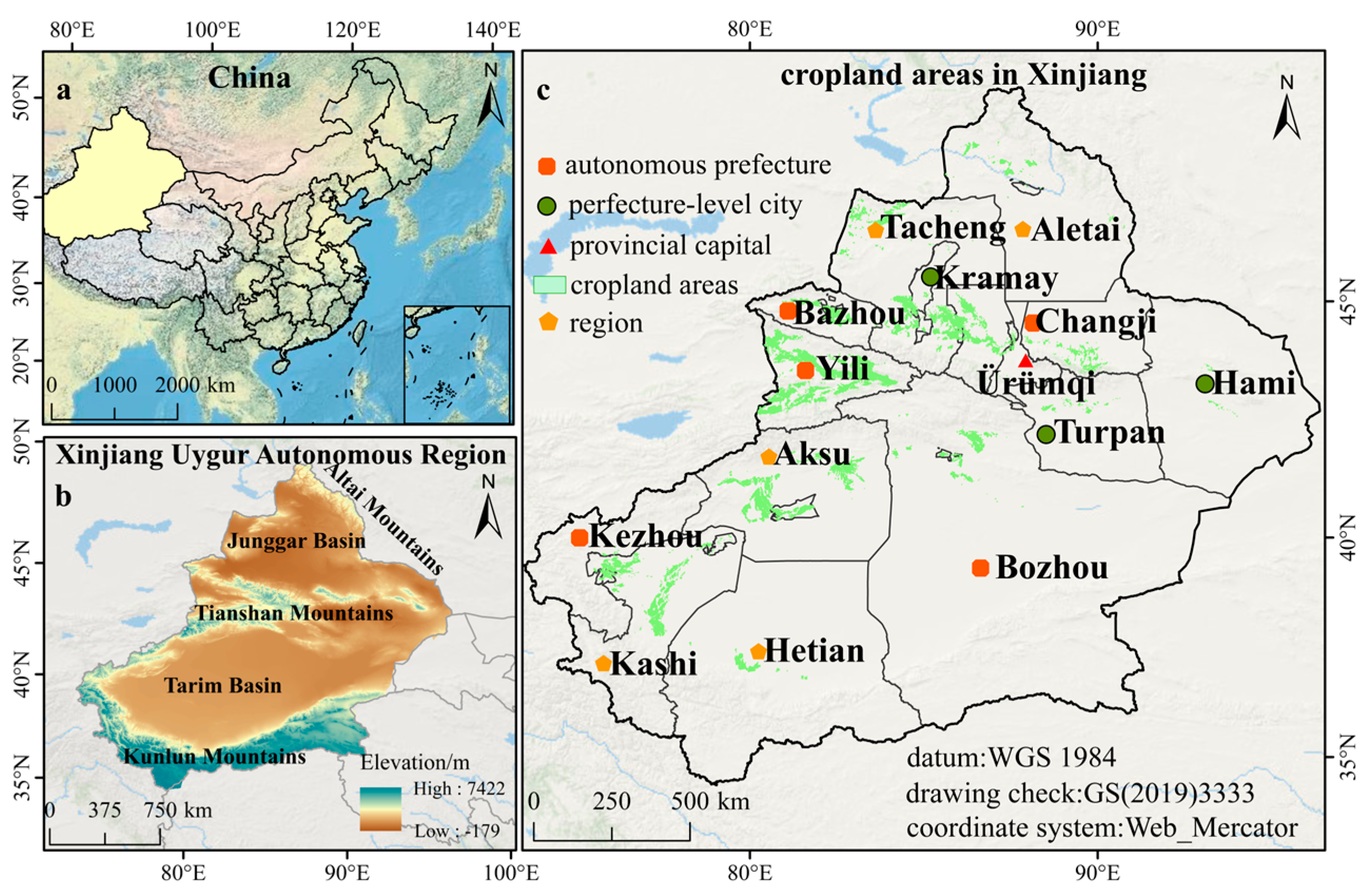
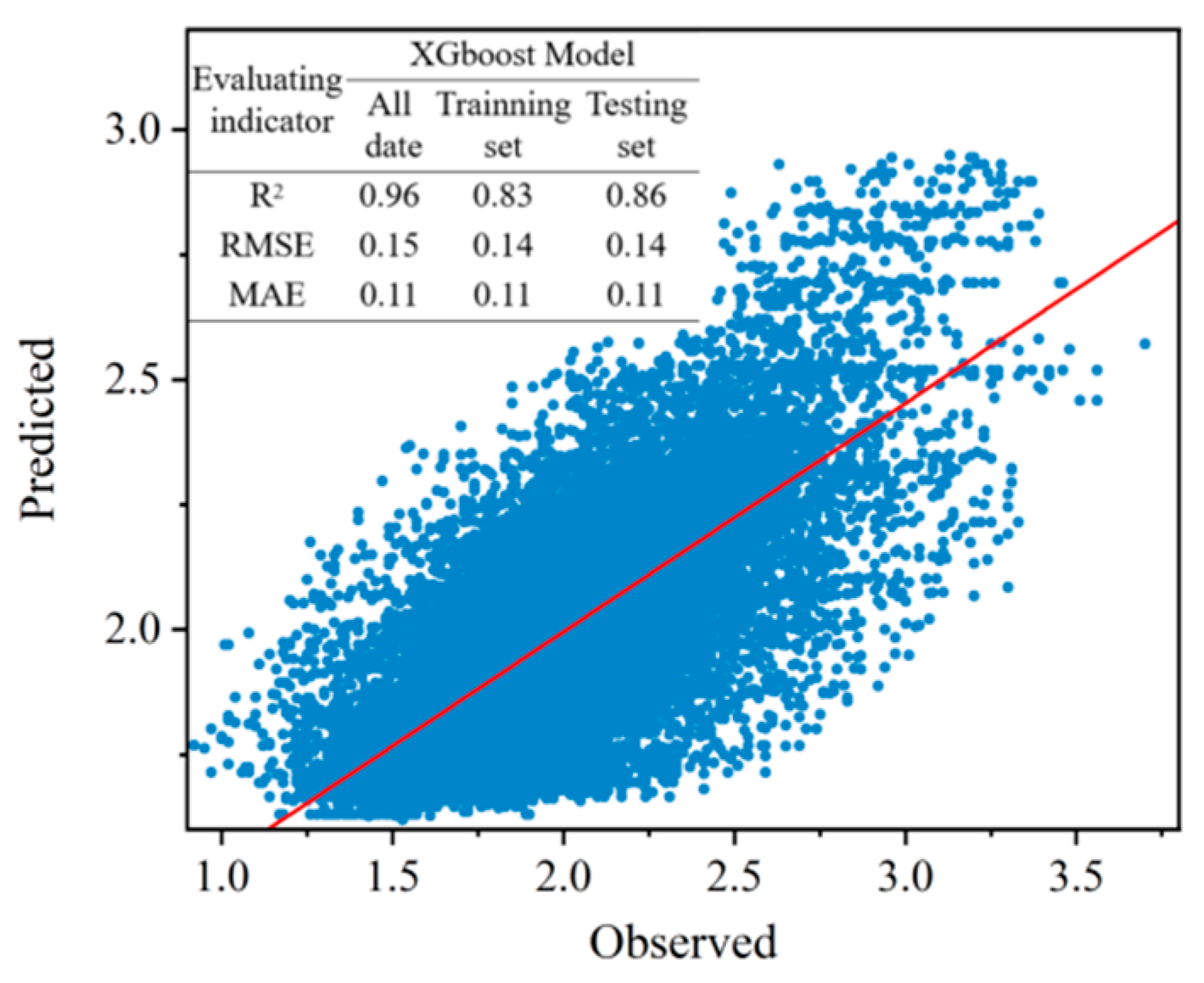
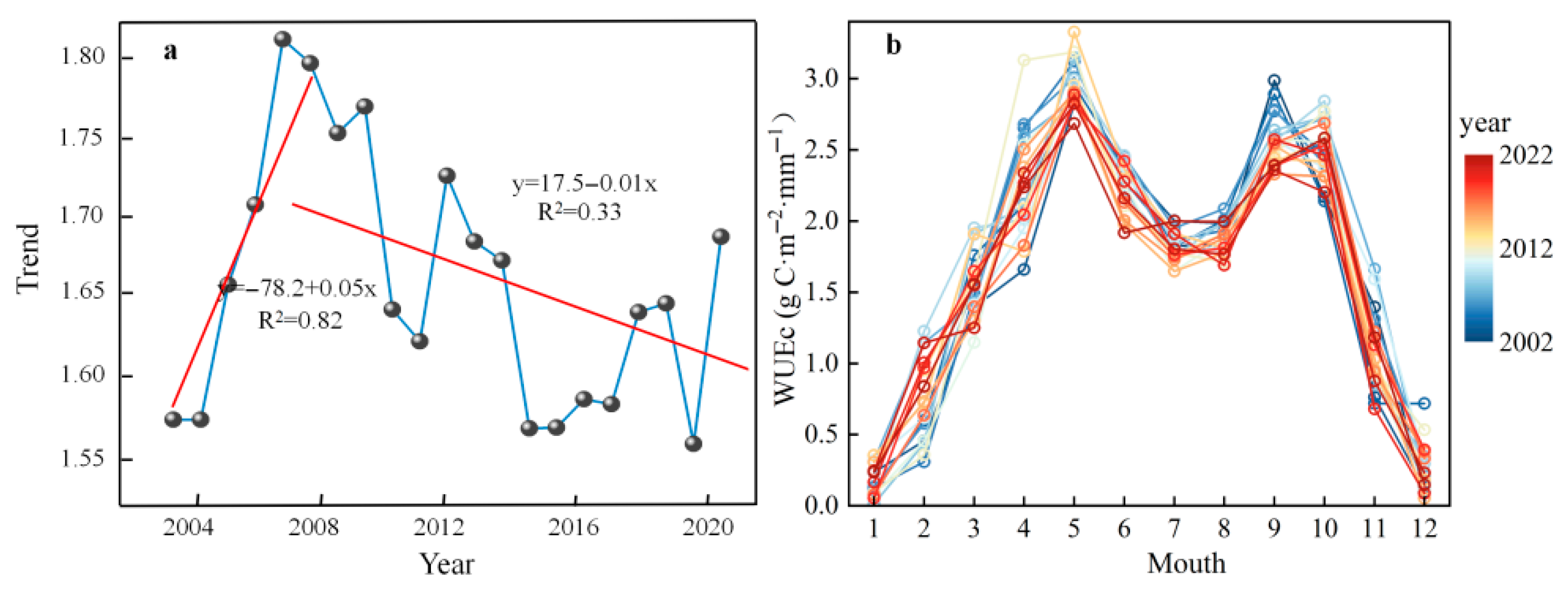
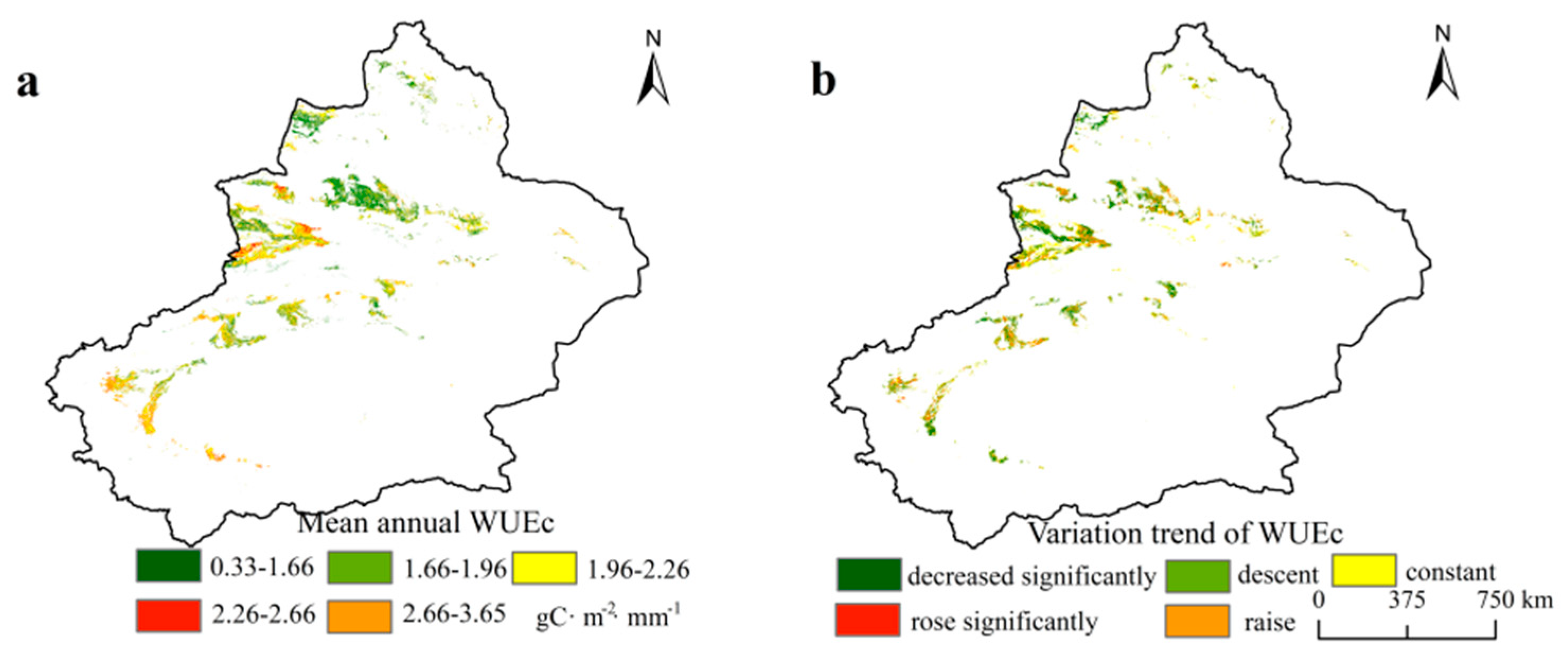
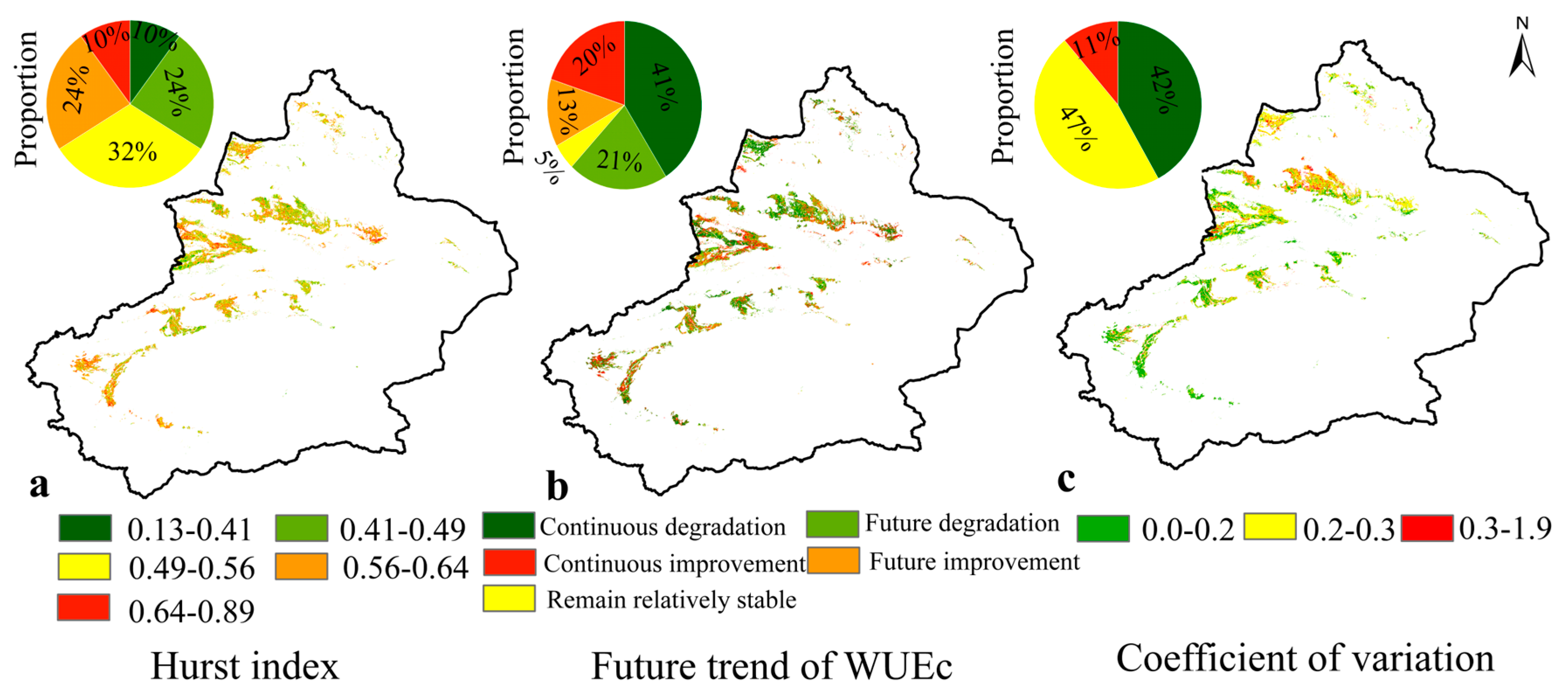
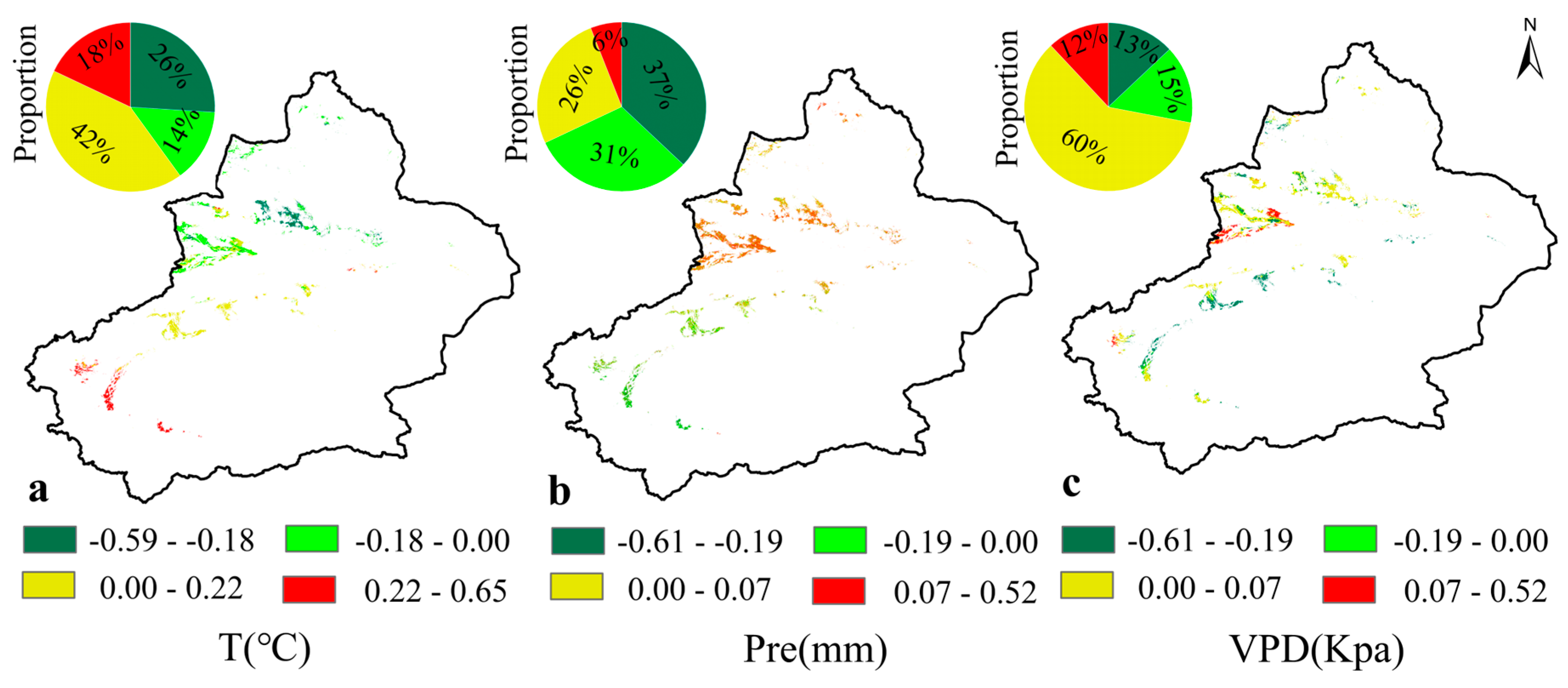
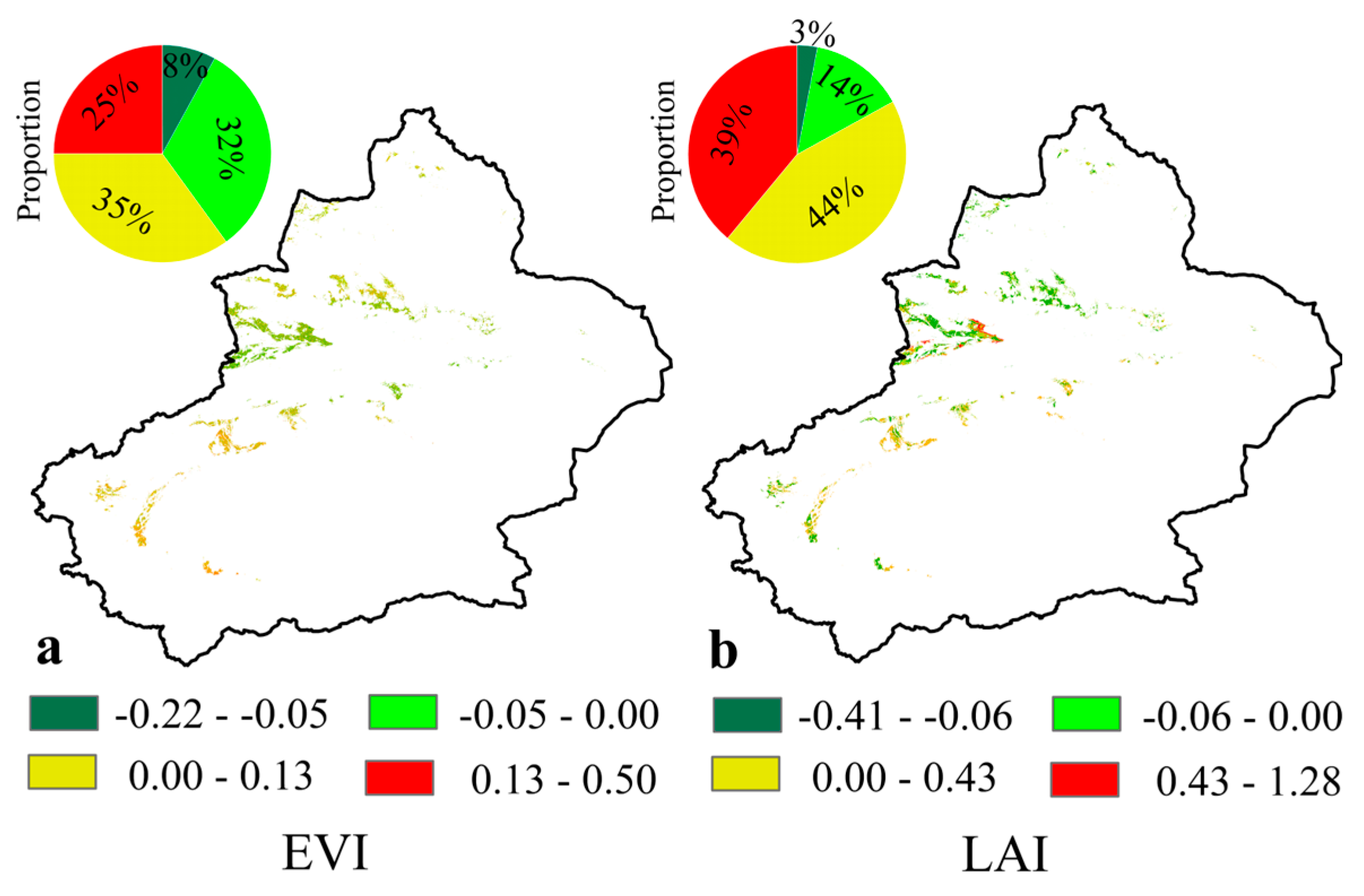
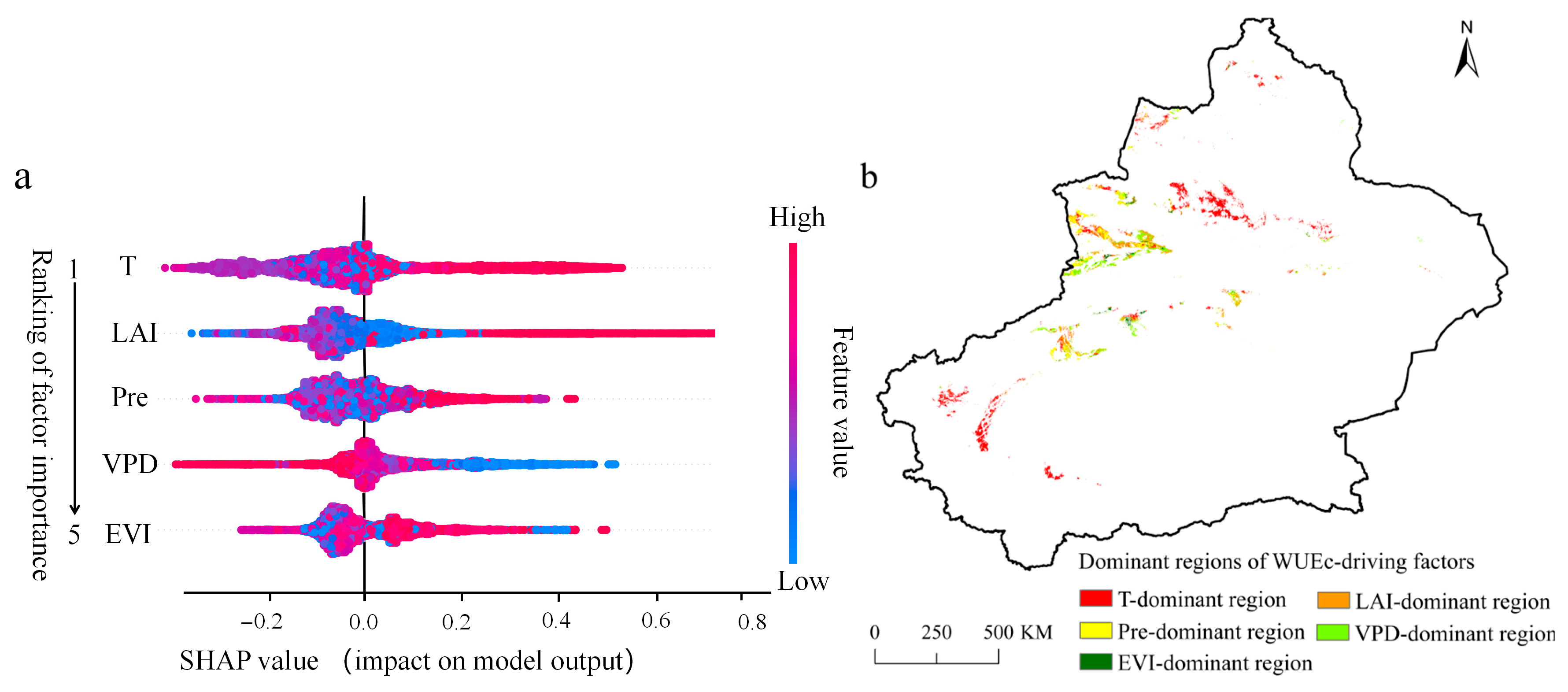
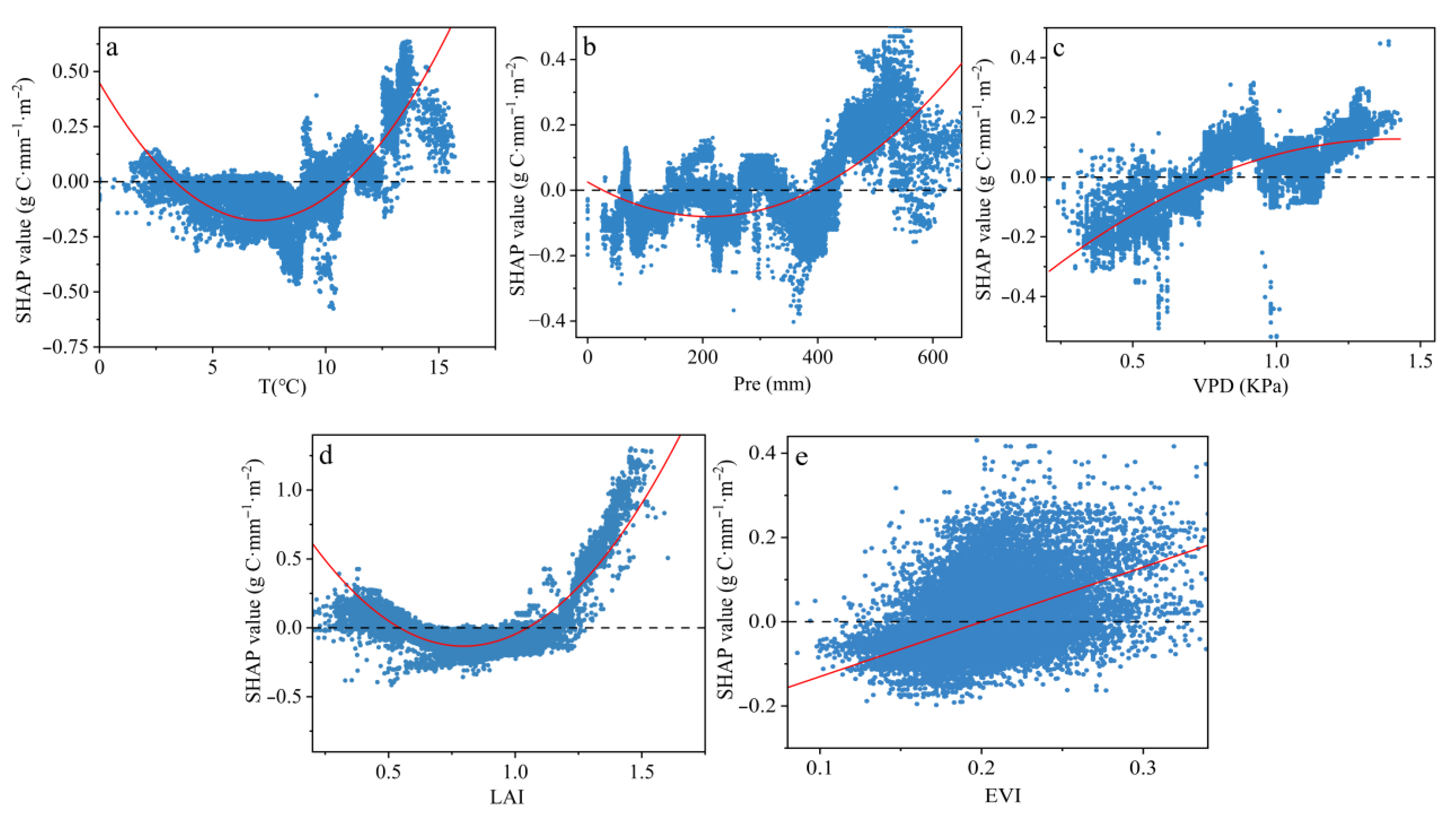
| Data Classification | Data Name | Temporal Resolution | Spatial Resolution | Year | Data Source |
|---|---|---|---|---|---|
| Land-use type data | CLCD | 1 year | 30 m | 2002–2022 | China Land Cover Dataset |
| Vegetation data | GPP/gC·m−2 | 1 month | 500 m | 2002–2022 | MODIS MYD17A2H |
| ET/mm | 1 month | 500 m | 2002–2022 | MODIS MOD16A2 | |
| EVI LAI | 1 year 1 year | 1000 m 500 m | 2002–2022 | MODIS MOD13A1 MODIS MOD13A1 | |
| Meteorological data | T/℃ | 1 year | 1000 m | 2002–2022 | National Earth System Science Data Center |
| Pre/mm | 1 year | 1000 m | 2002–2022 | National Earth System Science Data Center | |
| VPD/Kpa | 1 year | 1000 m | 2002–2022 | TerraClimate |
| Factor Importance on WUEc | Ta | LAI | Pre | VPD | EVI |
|---|---|---|---|---|---|
| Factor importance index (gC·mm−1·m−2) | 0.15 | 0.1 | 0.09 | 0.08 | 0.05 |
| Proportion of dominant factor regions (%) | 45.7 | 17.6 | 17.4 | 14.7 | 4.6 |
Disclaimer/Publisher’s Note: The statements, opinions and data contained in all publications are solely those of the individual author(s) and contributor(s) and not of MDPI and/or the editor(s). MDPI and/or the editor(s) disclaim responsibility for any injury to people or property resulting from any ideas, methods, instructions or products referred to in the content. |
© 2025 by the authors. Licensee MDPI, Basel, Switzerland. This article is an open access article distributed under the terms and conditions of the Creative Commons Attribution (CC BY) license (https://creativecommons.org/licenses/by/4.0/).
Share and Cite
Zhao, Q.; Gao, F.; He, B.; Li, Y.; Li, H.; Xiao, Y.; Lin, R. Analysis of Temporal and Spatial Variations in Cropland Water-Use Efficiency and Influencing Factors in Xinjiang Based on the XGBoost–SHAP Model. Agronomy 2025, 15, 1902. https://doi.org/10.3390/agronomy15081902
Zhao Q, Gao F, He B, Li Y, Li H, Xiao Y, Lin R. Analysis of Temporal and Spatial Variations in Cropland Water-Use Efficiency and Influencing Factors in Xinjiang Based on the XGBoost–SHAP Model. Agronomy. 2025; 15(8):1902. https://doi.org/10.3390/agronomy15081902
Chicago/Turabian StyleZhao, Qiu, Fan Gao, Bing He, Ying Li, Hairui Li, Yao Xiao, and Ruzhang Lin. 2025. "Analysis of Temporal and Spatial Variations in Cropland Water-Use Efficiency and Influencing Factors in Xinjiang Based on the XGBoost–SHAP Model" Agronomy 15, no. 8: 1902. https://doi.org/10.3390/agronomy15081902
APA StyleZhao, Q., Gao, F., He, B., Li, Y., Li, H., Xiao, Y., & Lin, R. (2025). Analysis of Temporal and Spatial Variations in Cropland Water-Use Efficiency and Influencing Factors in Xinjiang Based on the XGBoost–SHAP Model. Agronomy, 15(8), 1902. https://doi.org/10.3390/agronomy15081902





